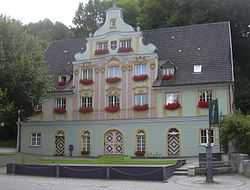Königsbronn
| Königsbronn | ||
|---|---|---|
 | ||
| ||
 Königsbronn | ||
Location of Königsbronn within Heidenheim district 
 | ||
| Coordinates: 48°44′34″N 10°6′49″E / 48.74278°N 10.11361°ECoordinates: 48°44′34″N 10°6′49″E / 48.74278°N 10.11361°E | ||
| Country | Germany | |
| State | Baden-Württemberg | |
| Admin. region | Stuttgart | |
| District | Heidenheim | |
| Government | ||
| • Mayor | Michael Stütz | |
| Area | ||
| • Total | 45.46 km2 (17.55 sq mi) | |
| Elevation | 498 m (1,634 ft) | |
| Population (2012-12-31)[1] | ||
| • Total | 7,000 | |
| • Density | 150/km2 (400/sq mi) | |
| Time zone | CET/CEST (UTC+1/+2) | |
| Postal codes | 89551 | |
| Dialling codes | 07328 | |
| Vehicle registration | HDH | |
| Website | www.koenigsbronn.de | |
Königsbronn is a municipality in the district of Heidenheim in Baden-Württemberg in southern Germany. Königsbronn (Koenigsbronn) as an administrative community also includes the villages of Itzelberg, Ochsenberg and Zang. It lies in the Brenz valley within the hills of the Swabian Jura, a landscape shaped by karst (limestone). A spring near the town center is the source of the Brenz, a tributary of the Danube.
History
There is some evidence that the area was first populated in the stone age.
The foundations of a castle of the early Middle Ages possibly erected around 1000 AD on the site of an even earlier castle, of robber-knights, as it is being told can be found on the rock Herwartstein overlooking the valley, which was allegedly destroyed by the son of the emperor of Holy Roman Empire of mediaeval Germany.
Below, In the valley, a hamlet called "Springen" had formed.
In 1303, a monastery was founded (and allegedly erected with stones from the destroyed castle) for Cistercian monks. It was to become one of the most influential and wealthiest monasteries in Southern Germany. The place was renamed "Königsbronn" which means "Kings's Spring".
In 1552, the monastery and village that had grown next to it were destroyed and a year later the area became Protestant (Lutheran). When the village was supposed to turn catholic again in 1629, the population rebelled and stayed Protestant.
The monastery had been a centre of pre-industrial-age metallurgy and in 1366 had been granted the right to mine and process iron ore from Emperor Charles IV., only one year after he had given it erroneously to a local count. The monks then started what became later the industrial company with the longest historic tradition in Germany, the Schwäbische Hüttenwerke GmbH. 1651 a furnace was lit and smelting didn't stop until 1908, when it had ceased to be profitable. However, the business was successfully shifted to finished products, especially to calender rolls for the paper industry, which made Königsbronn and SHW famous. Two out of three state of the art calender rolls in modern paper machines worldwide have been poured in the Königsbronn foundry, which today is a part of SHW Casting Technologies GmbH, a group of foundries specialized on heavy and highly precise castings.
The small but splendid rococo-style (or late baroque) town hall was erected in 1765 and gives a hint of the proud spirits of the town at the time.
In 1864, Koenigsbronn got railway access. The railway line has recently been refurbished to modern standards.
On 8 November 1939, a bomb placed by Georg Elser, who had spent much of his life in Königsbronn, detonated in Munich and missed its target Hitler by only minutes.
Recent history and present
After the war, many some small industrial companies in the wider area had to close, but some grew to become very successful, e.g. Voith in Heidenheim. Others moved in, e.g. Zeiss in the neighbouring town of Oberkochen. Industry has switched from heavy to high-tech and the second sector of the economy remains by far the most important, whereas climate and soil have never made agriculture too attractive in this region.
References
- ↑ [Statistisches Bundesamt – Gemeinden in Deutschland mit Bevölkerung am 31.12.2012 (XLS-Datei; 4,0 MB) (Einwohnerzahlen auf Grundlage des Zensus 2011) "Gemeinden in Deutschland mit Bevölkerung am 31.12.2012"]. Statistisches Bundesamt (in German). 12 November 2013.
- This article incorporates information from the German Wikipedia.
| |||||||
